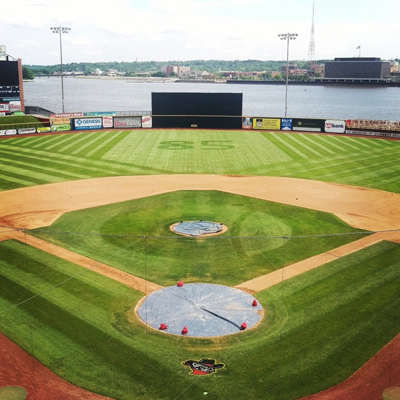5585 Guilford Road • Madison, WI 53711-5801 • 608-273-8080 • Fax 608-273-2021
www.agronomy.org
Twitter | Facebook
NEWS RELEASE
Contact: Hanna Jeske, Associate Director of Marketing and Brand Strategy, 608-268-3972, hjeske@sciencesocieties.org
How do they make those crazy designs on major league baseball outfields?
Oct. 22, 2018– Does baseball have you seeing stripes, diamonds, and circles? The Oct. 22nd Sustainable, Secure Food blog explains the turf maintenance and mowing practices that make baseball infields and outfields a visual feast.
 The light and dark green shadings on turf are the result of bending grass in different directions during the mowing process. “Mowers that make the best mowing pattern will have a solid roller that helps bend the grass. Laying turfgrass in different directions determines how the light will reflect off of it. Turfgrass blades laying towards you look dark. Those laying away from you look lighter in color,” explains Adam Thoms, Iowa State University.
The light and dark green shadings on turf are the result of bending grass in different directions during the mowing process. “Mowers that make the best mowing pattern will have a solid roller that helps bend the grass. Laying turfgrass in different directions determines how the light will reflect off of it. Turfgrass blades laying towards you look dark. Those laying away from you look lighter in color,” explains Adam Thoms, Iowa State University.
The home lawn enthusiast may be surprised to find the variety of equipment available to professional turf teams:
- A solid roller will help bend the grass in broad designs.
- Brooms can create intricate designs.
- Blasts of water can lay the grass down for detail.
- Streams of air, controlled by software, can create patterns in both directions at once.
Additionally, there are practical matters to consider, such as clear foul lines. “The mowing pattern of cool-season turfgrasses should always be parallel to the lines painted on the field to avoid the lines appearing wavy,” Thoms says. “Some mowers now have global positioning systems (GPS) on them to help with creating these mowing patterns and to make sure the lines they are producing are straight.”
To read the complete blog, visit Sustainable, Secure Food at https://wp.me/p9gkW1-76.
This blog is sponsored and written by members of the American Society of Agronomy and Crop Science Society of America. Our members are researchers and trained, certified professionals in the areas of growing our world’s food supply, while protecting our environment. They work at universities, government research facilities, and private businesses across the United States and the world.